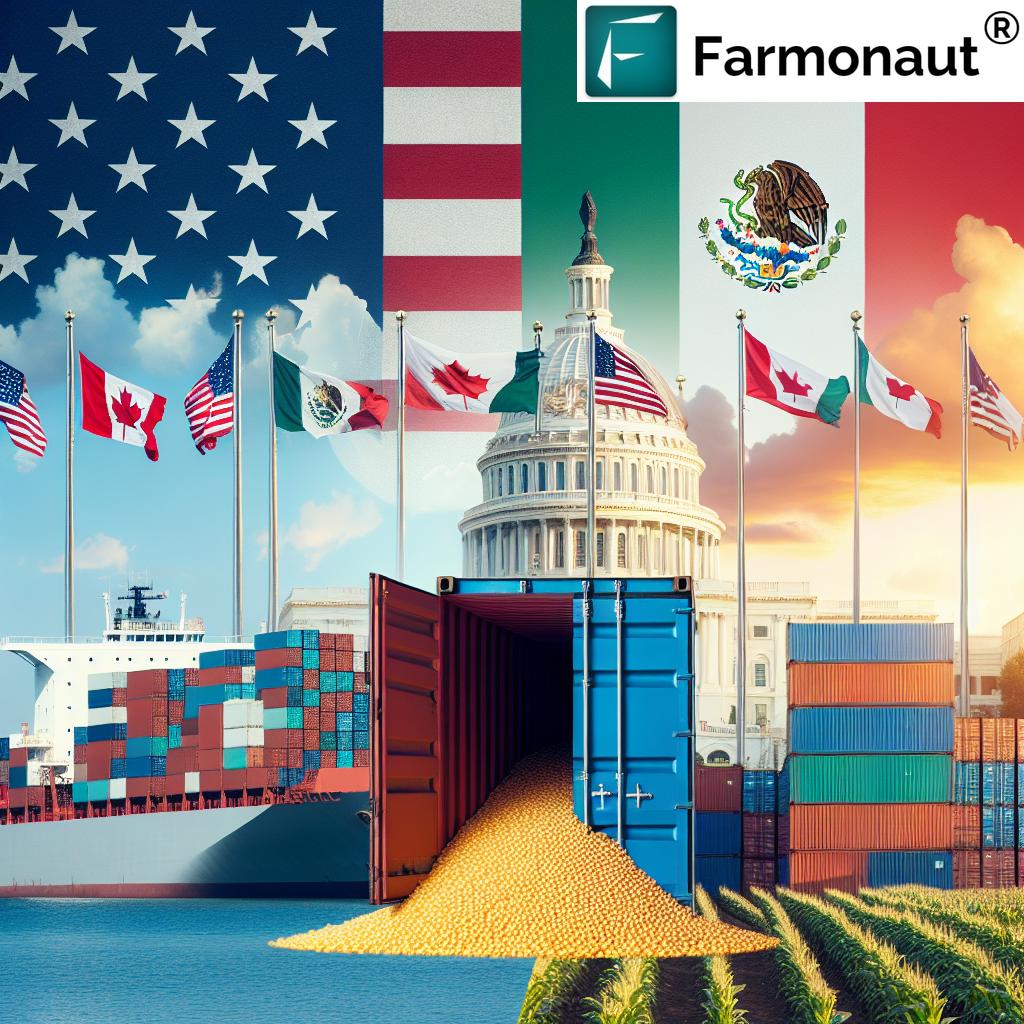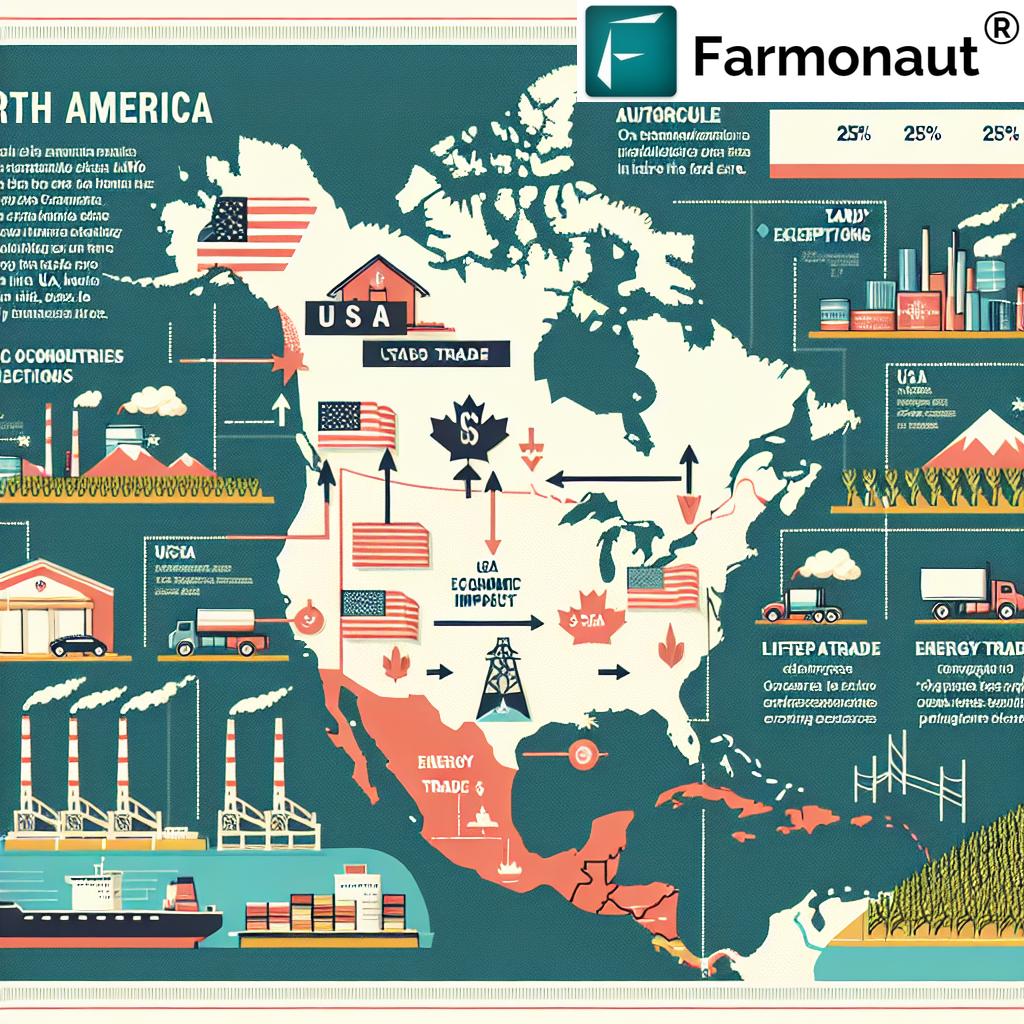USMCA Tariff Exemptions: How North American Trade Agreement Impacts US Agricultural Imports

“The USMCA tariff exemptions provide temporary relief from 25% tariffs on imported goods from Mexico and Canada.”
In the ever-evolving landscape of international trade, the United States-Mexico-Canada Agreement (USMCA) has emerged as a pivotal force reshaping North American economic relations. As we delve into the intricacies of this trade agreement, we’ll explore how recent USMCA tariff exemptions are significantly impacting US agricultural imports and broader trade dynamics with our northern and southern neighbors.
Understanding the USMCA: A New Era in North American Trade
The USMCA, successor to the North American Free Trade Agreement (NAFTA), marks a new chapter in the economic partnership between the United States, Mexico, and Canada. This agreement, aimed at modernizing North American trade, has introduced several key changes, particularly in the realm of tariffs and trade regulations.
Recent developments have seen the United States offer temporary relief from the 25% tariffs on imported goods from Mexico and Canada. This move has sent ripples through various sectors, most notably affecting agricultural imports, automotive industries, and energy products.
The Impact on US Agricultural Imports
The agricultural sector stands as one of the most significantly affected by these tariff exemptions. Let’s break down how these changes are reshaping the landscape of US agricultural imports:
- Dairy Products: Canadian dairy exports to the US have seen increased market access, potentially leading to more competitive pricing for US consumers.
- Grain and Cereals: The flow of wheat, corn, and other grains between the three nations is expected to become more fluid, benefiting farmers and consumers alike.
- Fruits and Vegetables: Mexican produce, a staple in US markets, may see reduced import costs, potentially leading to more affordable prices for American consumers.
- Meat Products: The trade of beef, pork, and poultry across North American borders is anticipated to become more streamlined under the new exemptions.
These changes not only affect the prices and availability of agricultural products but also have broader implications for farm incomes, consumer choices, and food security in the United States.
Beyond Agriculture: Wide-Ranging Effects of USMCA Tariff Exemptions
“USMCA trade policy changes impact multiple sectors, including agriculture, automotive, energy, fertilizers, and potash imports.”
While agricultural imports are a key focus, the USMCA tariff exemptions cast a wide net across various industries:
- Automotive Sector: The exemption of automobiles and parts that meet USMCA requirements from the 25% tariffs is a significant development. This move is poised to maintain the integrated North American auto supply chain, crucial for the industry’s competitiveness.
- Energy Products: With energy products from Canada facing a lower 10% duty, we anticipate potential shifts in energy trade dynamics and pricing structures.
- Fertilizers and Potash: Canadian potash, vital for US agricultural production, now faces a reduced 10% duty. This change could have ripple effects on fertilizer prices and, consequently, on US farm production costs.
These sector-specific impacts underscore the complex interplay between tariff policies and economic outcomes across North America.
The Economic Implications of Tariff Exemptions
The economic impact of these tariff exemptions is multifaceted and far-reaching. Here’s a closer look at some key aspects:
- Trade Balance: The exemptions are likely to influence the trade balance between the US and its North American partners. We may see shifts in import-export ratios across various sectors.
- Consumer Prices: With reduced tariffs on many goods, US consumers might benefit from more competitive pricing on a range of products, from fresh produce to automobiles.
- Industry Competitiveness: Sectors benefiting from these exemptions may see enhanced competitiveness, both within North America and globally.
- Job Market Impacts: Changes in trade dynamics could influence job markets across various industries, potentially leading to shifts in employment patterns.
As we navigate these changes, it’s crucial to consider both the immediate and long-term economic implications of these tariff exemptions.
International Trade Negotiations: A Delicate Balance
The USMCA tariff exemptions highlight the intricate nature of international trade negotiations. These developments are not occurring in isolation but are part of a broader context of global trade relations. Key considerations include:
- Global Trade Tensions: The exemptions come at a time of ongoing trade tensions with other major partners, notably China.
- Policy Flexibility: The temporary nature of these exemptions underscores the fluid nature of trade policy, allowing for adjustments based on economic and political factors.
- Diplomatic Relations: Trade policies often serve as barometers for diplomatic relations. The USMCA exemptions reflect the current state of US relations with Mexico and Canada.
Understanding these broader contexts is crucial for businesses and policymakers alike as they navigate the evolving landscape of North American trade.
Comparative Analysis of USMCA Tariff Exemptions
| Product Category | Pre-USMCA Tariff Rate | Current USMCA Tariff Rate | Estimated Annual Import Value (USD) |
|---|---|---|---|
| Dairy Products | 20-25% | 0-5% | $2.5 billion |
| Grain | 10-15% | 0% | $3.1 billion |
| Fruits and Vegetables | 15-20% | 0-10% | $14 billion |
| Meat Products | 18-22% | 0-5% | $5.7 billion |
| Fertilizers and Potash | 25% | 10% | $2.3 billion |
This table provides a clear overview of how the USMCA has altered tariff rates across key agricultural import categories, along with their economic significance. It’s evident that substantial reductions in tariff rates have been implemented, potentially leading to significant changes in trade volumes and economic impacts.
The Role of Technology in Modern Agriculture
As we discuss these significant trade policy changes, it’s important to recognize the role of technology in modern agriculture. Companies like Farmonaut are at the forefront of agricultural innovation, offering solutions that can help farmers navigate these changing economic landscapes more effectively.
Farmonaut’s satellite-based farm management solutions provide valuable tools for farmers to optimize their operations in response to market changes. By leveraging advanced technologies such as satellite imagery and AI-driven insights, farmers can make more informed decisions about crop management, potentially mitigating some of the impacts of changing trade dynamics.
Implications for US Farmers and Agribusinesses
The USMCA tariff exemptions have significant implications for US farmers and agribusinesses:
- Competitive Pressure: Increased imports may put pressure on domestic producers to remain competitive.
- Export Opportunities: Conversely, reduced barriers may open up new export opportunities for US agricultural products.
- Supply Chain Adjustments: Farmers and agribusinesses may need to reassess and potentially restructure their supply chains in light of these changes.
- Technology Adoption: To remain competitive, there may be an increased need for technology adoption in farming practices.
In this context, tools like Farmonaut’s satellite and weather API can provide crucial data for agribusinesses to make informed decisions in this changing landscape.
The Future of North American Trade Relations
Looking ahead, the future of North American trade relations under the USMCA appears dynamic and evolving:
- Ongoing Negotiations: The temporary nature of some exemptions suggests that trade discussions will continue to be a focal point in North American relations.
- Technological Integration: As trade becomes more seamless, we may see increased technological integration across North American supply chains.
- Environmental Considerations: Future trade negotiations may increasingly incorporate environmental standards and sustainability practices.
- Digital Trade: The growing importance of digital trade and e-commerce may lead to new provisions and agreements within the USMCA framework.
As these developments unfold, staying informed and adaptable will be key for businesses operating within this trilateral trade ecosystem.
Leveraging Technology in Agriculture Amidst Trade Changes
In light of these trade policy shifts, the role of agricultural technology becomes even more crucial. Farmonaut’s suite of tools can help farmers and agribusinesses adapt to these changes:
- Crop Health Monitoring: Real-time satellite-based crop health monitoring can help farmers optimize yields and quality, crucial for maintaining competitiveness in a changing market.
- AI-Driven Insights: Farmonaut’s AI advisory system can provide tailored recommendations, helping farmers make informed decisions in response to market fluctuations.
- Resource Management: Efficient resource management tools can help reduce operational costs, offsetting potential impacts of market changes.
The Broader Economic Context
The USMCA tariff exemptions are part of a larger economic picture:
- Global Supply Chains: These changes may influence global supply chain strategies, potentially leading to more regionalized trade patterns.
- Investment Flows: Altered trade dynamics could impact investment decisions across North America, potentially shifting capital flows between sectors and countries.
- Currency Impacts: Changes in trade balances may influence currency exchange rates among the three nations, with broader economic implications.
Understanding these broader economic contexts is crucial for businesses navigating the new trade landscape.
Challenges and Opportunities in the New Trade Landscape
The USMCA tariff exemptions present both challenges and opportunities:
Challenges:
- Adapting to new competitive pressures from increased imports
- Navigating potentially complex compliance requirements
- Managing supply chain disruptions during the transition period
Opportunities:
- Exploring new export markets within North America
- Leveraging reduced input costs for improved competitiveness
- Collaborating on cross-border innovations and technologies
Businesses that can effectively navigate these challenges while capitalizing on opportunities stand to gain significantly in this new trade environment.
The Role of Policy in Shaping Agricultural Trade
Policy decisions play a crucial role in shaping agricultural trade:
- Subsidy Programs: Changes in subsidy programs can significantly impact the competitiveness of agricultural products across borders.
- Regulatory Harmonization: Efforts to align regulations across the three countries can facilitate smoother trade flows.
- Environmental Policies: Increasing focus on sustainability may lead to new trade standards and practices in agriculture.
Staying informed about these policy developments is crucial for stakeholders in the agricultural sector.
Technological Innovations Driving Agricultural Efficiency
In the context of changing trade dynamics, technological innovations are becoming increasingly important in agriculture:
- Precision Agriculture: Technologies like those offered by Farmonaut enable more precise and efficient farming practices, crucial for maintaining competitiveness.
- Data-Driven Decision Making: Access to real-time data and analytics can help farmers and agribusinesses make more informed decisions in response to market changes.
- Blockchain for Traceability: Blockchain technology can enhance supply chain transparency, potentially facilitating smoother international trade.
Earn With Farmonaut: Affiliate Program
Earn 20% recurring commission with Farmonaut’s affiliate program by sharing your promo code and helping farmers save 10%. Onboard 10 Elite farmers monthly to earn a minimum of $148,000 annually—start now and grow your income!
Consumer Impact: From Farm to Table
The USMCA tariff exemptions have implications that extend all the way to the consumer level:
- Food Prices: Changes in import costs may influence retail prices of various food products.
- Product Variety: Increased trade could lead to a wider variety of products available to consumers.
- Quality Standards: Harmonized regulations might result in more consistent quality standards across North American agricultural products.
These consumer-level impacts highlight the far-reaching effects of trade policy changes.
Environmental Considerations in Agricultural Trade
Environmental factors are increasingly intertwined with agricultural trade policies:
- Sustainable Practices: Trade agreements may incentivize more sustainable farming practices across North America.
- Carbon Footprint: Considerations of transportation distances and modes may influence trade patterns and preferences.
- Water Usage: With water scarcity a growing concern, efficient water use in agriculture may become a key factor in trade negotiations.
Tools like Farmonaut’s satellite-based monitoring can play a crucial role in helping farmers adopt more sustainable practices while maintaining productivity.
The Future of Agricultural Technology in Trade
As we look to the future, the intersection of agricultural technology and international trade becomes increasingly important:
- Cross-Border Data Sharing: Technologies facilitating the sharing of agricultural data across borders could enhance productivity and trade efficiency.
- AI in Trade Forecasting: Advanced AI systems could help predict trade trends and market demands, aiding in policy and business decision-making.
- IoT in Supply Chain Management: Internet of Things (IoT) technologies could revolutionize how agricultural products are tracked and traded across North America.
Companies like Farmonaut are at the forefront of these technological advancements, providing tools that can help the agricultural sector adapt to and thrive in this evolving trade landscape.
Conclusion: Navigating the New North American Trade Landscape
The USMCA tariff exemptions mark a significant shift in North American trade relations, with far-reaching implications for US agricultural imports and beyond. As we’ve explored, these changes present both challenges and opportunities across various sectors, from farming and manufacturing to energy and technology.
Key takeaways include:
- The multifaceted impact of tariff exemptions on different agricultural sectors
- The broader economic implications for North American trade relations
- The increasing importance of technology in navigating these trade changes
- The need for businesses to stay informed and adaptable in this evolving landscape
As we move forward, the ability to leverage data, technology, and strategic insights will be crucial for stakeholders across the agricultural sector. Tools and platforms like those offered by Farmonaut will play an increasingly vital role in helping farmers and agribusinesses thrive in this new era of North American trade.
The landscape of international trade is ever-changing, and the USMCA tariff exemptions are just one piece of a complex puzzle. By staying informed, embracing innovation, and adapting to new realities, businesses can not only navigate these changes but also find new opportunities for growth and success in the evolving North American market.
FAQs
- What are the main agricultural products affected by the USMCA tariff exemptions?
The main agricultural products affected include dairy, grains, fruits and vegetables, and meat products. These exemptions have significant impacts on trade volumes and pricing for these goods. - How do the USMCA tariff exemptions impact US farmers?
US farmers may face increased competition from imports but also benefit from reduced costs on certain inputs and potentially expanded export opportunities. The overall impact varies depending on the specific agricultural sector. - Are the USMCA tariff exemptions permanent?
Many of the exemptions are temporary and subject to ongoing negotiations and reviews. It’s important for businesses to stay informed about any changes or extensions to these exemptions. - How does technology like Farmonaut’s solutions help in adapting to these trade changes?
Farmonaut’s technologies, such as satellite-based crop monitoring and AI-driven insights, can help farmers optimize their operations, making them more competitive in a changing market landscape. These tools provide data-driven decision-making capabilities crucial for adapting to new trade dynamics. - What are the potential long-term effects of these tariff exemptions on North American trade relations?
Long-term effects may include more integrated supply chains across North America, shifts in investment patterns, and potentially more harmonized regulatory standards. However, the full impact will depend on ongoing negotiations and global economic trends.
















